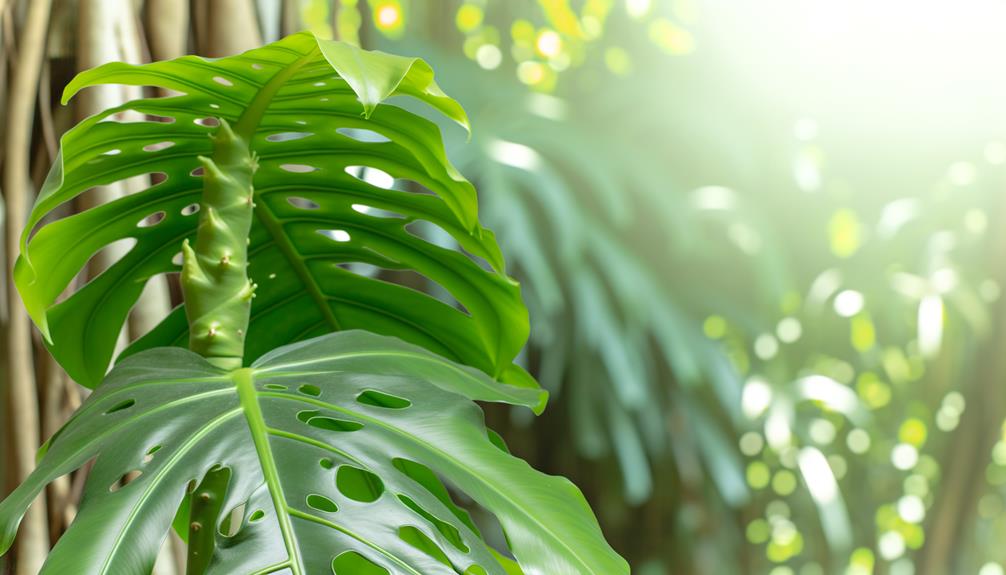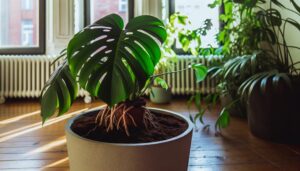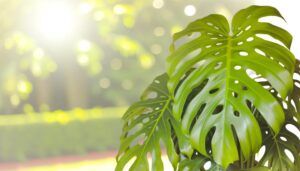Monstera Acacoyaguensis Plant Growth
To optimize Monstera acacoyaguensis growth, mimic its native rainforest conditions. Provide bright, indirect light; direct sunlight can cause leaf scorch.
Maintain high humidity (60-80%) and keep temperatures between 65-80°F. Use well-draining soil enriched with organic matter and water consistently, avoiding oversaturation.
Fertilize bi-weekly with a balanced, water-soluble formula during the growing season, reducing in cooler months. Prune with sterilized tools and monitor for pests like spider mites and mealybugs.
Propagate through stem cuttings or air layering. Observing these conditions guarantees vigorous growth and fenestrated leaf development.
Cultivating under these parameters will reveal more intricate growth dynamics.

Key Takeaways
- Thrives in bright, indirect light conditions resembling rainforest environments.
- Requires well-draining soil rich in organic matter to prevent root rot.
- Ideal temperature range is 65-80°F with humidity levels of 60-80%.
- Regular feeding with balanced, water-soluble fertilizer during growth months.
- Propagates effectively via stem cuttings, air layering, or division.
Origin and Background
The Monstera acacoyaguensis, a species endemic to the rainforests of Central and South America, particularly thrives in the humid, shaded environments of Mexico and Guatemala.
You'll find this hemiepiphytic plant clinging to trees, utilizing its aerial roots to anchor itself while absorbing moisture and nutrients. Its large, fenestrated leaves maximize photosynthetic efficiency in low-light conditions, an essential adaptation for survival in dense canopies.
The species exhibits high adaptability, often colonizing both primary and secondary forests. Taxonomically, it belongs to the Araceae family, which is characterized by flowering structures known as spadices enclosed in spathes.
The Monstera acacoyaguensis plays a significant role in its ecosystem, providing habitat and food for various fauna and contributing to the forest's structural complexity.
Ideal Light Conditions
Given its natural habitat in the dense canopies of rainforests, Monstera acacoyaguensis thrives in filtered, indirect light that mimics the dappled sunlight of its native environment. To replicate these conditions, position your plant in an area where it receives bright, indirect light for most of the day.
Avoid direct sunlight, which can scorch the leaves, causing chlorosis and photoinhibition. Best light conditions promote photosynthetic efficiency, enhancing leaf morphology and fenestration. Utilize sheer curtains or place the plant near an east or north-facing window.
Artificial grow lights with a spectral output between 400-700 nm can also supplement natural light. Monitoring light intensity with a photometer guarantees the plant receives approximately 2000-3000 foot candles for the utmost growth.
Watering Requirements
When determining the best watering frequency for Monstera acacoyaguensis, you should consider the plant's natural environment, which includes well-draining soil and occasional rainfall.
Watch for indications of excessive watering, like yellowing leaves and root decay, to avoid negative impacts on plant health.
Strive to sustain steady moisture levels without completely soaking the soil, ensuring adequate air circulation and hydration equilibrium.
Optimal Watering Frequency
Consistently supervise soil moisture levels to guarantee Monstera acacoyaguensis receives sufficient hydration without becoming waterlogged. Utilize a hygrometer to measure soil moisture content accurately. Aim to water when the top 2-3 inches of soil are dry to the touch.
This plant thrives in well-draining soil; avoid allowing it to sit in water. Adjust watering frequency based on environmental conditions; higher temperatures and increased light will necessitate more frequent watering. Ensure even distribution of water to prevent root desiccation or saturation.
Employ a watering schedule but remain adaptable to the plant's specific needs. Observing wilting or drooping can indicate insufficient hydration, while consistently wet soil may lead to root rot. Precision in watering fosters optimal growth and plant health.
Signs of Overwatering
Overwatering your Monstera acacoyaguensis often manifests through yellowing leaves, a telltale sign of root oxygen deprivation and potential root rot. You'll observe chlorosis, where the leaf tissue loses chlorophyll, leading to discolored foliage.
Examine the soil; if it remains perpetually soggy, anaerobic conditions could be impairing root respiration, fostering pathogenic fungi like Pythium. Additionally, look for wilting, despite the abundance of water—a paradoxical symptom of impaired root function.
Mushy, darkened roots, when inspected, indicate severe rot. High humidity and stagnant water exacerbate these conditions, promoting fungal growth. Prevent these issues by ensuring well-draining soil and allowing the substrate to dry between waterings, maintaining a balanced moisture level and preventing hypoxic stress on the root system.
Soil Preferences
You should prioritize a well-draining soil with a high organic matter content for Monstera acacoyaguensis.
Prioritize the substrate includes components like perlite or orchid bark to enhance aeration and prevent waterlogging.
Monitoring the soil's pH, ideally between 5.5 and 7.0, will support best nutrient uptake and plant health.
Optimal Soil Composition
For best growth of Monstera Acacoyaguensis, a well-draining, aerated soil mix rich in organic matter is essential. You should incorporate a mix of peat moss, perlite, and orchid bark to achieve the necessary balance.
Peat moss retains moisture while providing essential nutrients, promoting root health. Perlite enhances soil aeration and prevents compaction, ensuring oxygen reaches the roots. Orchid bark contributes to the structural integrity of the soil, allowing for proper root expansion and moisture regulation.
Aim for a soil pH between 5.5 and 7.0, as this range maximizes nutrient availability. Regularly monitor the soil's organic content and adjust as needed, ensuring your Monstera Acacoyaguensis thrives in its best growing medium.
Drainage and Aeration
Ensuring proper drainage and aeration is paramount for the healthy growth of Monstera Acacoyaguensis, as it prevents root rot and promotes oxygenation. You should focus on creating a well-draining soil mix that balances moisture retention and air permeability.
Consider the following components:
- Perlite: Enhances drainage and aeration by creating air pockets within the soil.
- Pine Bark: Adds structure and allows roots to breathe, reducing compaction.
- Coconut Coir: Retains moisture without becoming waterlogged, promoting root health.
- Activated Charcoal: Absorbs excess moisture and toxins, keeping the root environment balanced.
Temperature and Humidity
Maintaining an ideal temperature range of 65-80°F and a humidity level of 60-80% is essential for the vigorous growth of Monstera Acacoyaguensis. You'll need to monitor ambient conditions closely, as deviations can stress the plant.
At temperatures below 65°F, metabolic processes slow, resulting in stunted growth. Conversely, temperatures above 80°F can lead to desiccation and leaf scorch.
Humidity plays a pivotal role in transpiration and nutrient uptake. If humidity drops below 60%, you'll see leaf curling and brown edges, indicative of water stress. Conversely, excessive humidity above 80% can foster pathogen proliferation, leading to fungal infections.
Utilize hygrometers and thermometers to maintain these ideal conditions, ensuring your Monstera thrives.
Fertilization Tips
When fertilizing Monstera Acacoyaguensis, you should prioritize a balanced, slow-release fertilizer to maintain consistent nutrient availability. Apply the fertilizer bi-monthly during the active growing season, and reduce frequency in dormant periods to prevent nutrient overload.
Monitoring the plant's response will help you adjust the schedule for best growth and health.
Ideal Fertilizer Types
Selecting the right fertilizer for Monstera Acacoyaguensis involves understanding the plant's specific nutrient requirements, with a focus on balanced ratios of nitrogen, phosphorus, and potassium. Aim for a 20-20-20 NPK formula for thorough nutrient support.
Here are four ideal fertilizer types:
- Granular Slow-Release Fertilizer: Ensuring consistent nutrient supply over time, reducing the risk of over-fertilization.
- Liquid Fertilizer: Allows for precise control of nutrient delivery, ideal for correcting deficiencies quickly.
- Organic Compost: Enhances soil structure and microbial activity, promoting long-term plant health.
- Foliar Feed: Directly absorbed through leaves, providing rapid nutrient uptake and immediate results.
Optimal Feeding Schedule
To promote peak growth and health of your Monstera Acacoyaguensis, establish a feeding schedule that aligns with its active growing phases and dormancy periods.
During the growth months (spring and summer), use a balanced, water-soluble fertilizer (20-20-20 NPK) every two weeks. Guarantee the nutrient solution reaches the root zone without waterlogging the substrate.
In fall and winter, reduce feeding frequency to once a month, as metabolic activities decline. Monitor foliar responses; yellowing or slow growth may indicate nutrient deficiencies. Adjust dosages based on observed plant health and environmental factors.
Avoid over-fertilization, as salt buildup can damage roots. Regularly flush the soil to prevent nutrient accumulation and ensure prime ionic exchange for sustained vigor.
Pruning Techniques
Pruning your Monstera Acacoyaguensis involves using sterilized, sharp tools to make clean cuts, promoting healthy growth and preventing disease. Begin by identifying damaged or yellowing leaves and cut them at the base. Ensure your cuts are angled to avoid water accumulation and subsequent rot.
Follow these steps:
- Inspect: Regularly check for overgrowth and signs of stress.
- Sterilize Tools: Use isopropyl alcohol to disinfect pruners before each cut.
- Cut Strategically: Remove not more than 25% of the foliage at once to prevent shock.
- Post-Pruning Care: Water adequately and monitor for any signs of stress.
Common Pests
Common pests that affect Monstera Acacoyaguensis include spider mites, mealybugs, and scale insects, which can cause significant damage if not promptly managed. Spider mites (Tetranychidae) thrive in dry conditions, leaving fine webbing and stippled leaves.
Mealybugs (Pseudococcidae) appear as white, cottony masses, secreting honeydew that promotes sooty mold growth. Scale insects (Coccoidea) attach firmly to stems and leaves, sucking sap and weakening the plant.
Regularly inspect your plant, focusing on leaf undersides and axils, as early detection is vital. Use insecticidal soap or neem oil for effective control. Maintain high humidity and clean foliage to deter infestations.
Biological controls, like predatory mites, can also help manage pest populations, ensuring your Monstera Acacoyaguensis thrives.
Propagation Methods
Understanding the propagation methods for Monstera Acacoyaguensis is essential for ensuring successful plant reproduction and maintaining genetic diversity within your collection.
You can propagate this species using several techniques:
- Stem Cuttings: Select a healthy stem with at least one node and aerial root. Place it in water or a well-draining substrate.
- Air Layering: Encourage root formation on the plant itself by wrapping a moist sphagnum moss around a node and covering it with plastic.
- Seed Propagation: Rarely done due to seed availability, but involves germinating seeds in a controlled environment.
- Division: Separate the root ball into sections, ensuring each has a viable shoot and root system.
Employing these methods will optimize your propagation success rate and plant health.
Growth Stages
The growth stages of Monstera Acacoyaguensis encompass a series of distinct phases. These include germination, juvenile development, mature growth, and potential dormancy, each characterized by specific physiological and morphological changes.
During germination, the seed undergoes imbibition, initiating radicle emergence.
In juvenile development, you'll observe the formation of primary leaves, characterized by their smaller size and simpler structure.
As the plant progresses to mature growth, fenestration and aerial roots become prominent, indicating increased photosynthetic capacity and nutrient acquisition.
Finally, potential dormancy may occur under suboptimal environmental conditions, marked by reduced metabolic activity and halted growth.
Understanding these stages allows you to optimize care and anticipate the plant's needs at each developmental phase, ensuring robust growth and essentiality.
Troubleshooting Issues
When your Monstera Acacoyaguensis displays symptoms like yellowing leaves, stunted growth, or root rot, it's important to diagnose the underlying issues promptly to ensure effective remediation.
To troubleshoot, consider the following:
- Watering Practices: Overwatering can lead to root rot. Guarantee the soil has well-draining properties and water only when the top inch feels dry.
- Light Exposure: Insufficient light may cause yellowing leaves. Place the plant in bright, indirect sunlight for best photosynthesis.
- Nutrient Availability: Lack of essential nutrients like nitrogen, phosphorus, or potassium can result in stunted growth. Use a balanced, water-soluble fertilizer.
- Pest Infestation: Spider mites and aphids can damage foliage. Regularly inspect leaves and use insecticidal soap if necessary.
Conclusion
To sum up, mastering the growth of your Monstera acacoyaguensis isn't as challenging as it seems. You'll find that with the right light, water, soil, temperature, and humidity, your plant will thrive.
Worried about pests? Regular monitoring and prompt action will keep them at bay. With precise propagation techniques and an understanding of growth stages, you'll cultivate a robust plant.
Don't let initial obstacles deter you—scientific precision guarantees your Monstera's flourishing growth.






